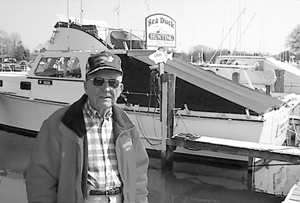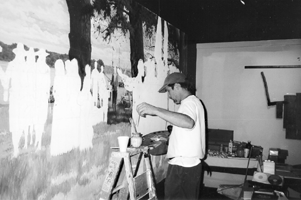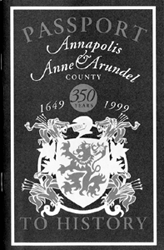
Dock of the Bay

Volume VII Number 13
April 1-7, 1999
Bay Life: At 80, 'Action' Jackson
Still a Capt. 
"I don't want no rocking chair to get me," says Capt. Kenneth Jackson, looking forward to his 80th birthday on April Fool's Day. "You're only as old as you feel, and I feel 29."
With such a zest for life, who can stop "Action" Jackson? The nickname, coined by Happy Harbor bartender J.R. Hvizda, has stayed with the waterman for years.
For 14 years and to this day he guides fishermen to the fish as a charter captain on Chesapeake Bay. Nowadays he spells Captain Frank Carver on the Loosen Up. Boats have been his life-long companion.
"My father bought me a 21-foot canoe when I was 12 years old. From then on, I always had a boat. My mother used to have to bring my dinner down to the Anacostia River," Jackson says.
Jackson wasn't much older when he met the other love of his life. As a young boy of 16 years, he first laid his eyes on future wife, Geraldine. He was an Eastern High schooler; she a 13-year-old Anacostia High student. After he drove her home twice, they became inseparable. The couple married June 26, 1942.
On July 28, 1942, his wife's 20th birthday and 28 days after their wedding, Jackson was drafted and went off to fight in World War II. That three years, six months, 22 days and 19 hour, (he remembers) was the longest time they spent apart.
After returning from the war, they drove to Deale every weekend. Geraldine refused to relocate to the area because she was a city girl at heart. Jackson reminisces about the $15,000 Deale waterfront home he wanted and the hard-shell crabs he caught that brought 35 cents a dozen. "Those were the good old days," Jackson teases, with a hint of nostalgia.
When their first child was born, Jackson continued the drive down on his own.
"In the wintertime I went her way; in the summertime she went my way," Jackson said.
His way was always the Bay.
After 33 years at St. Elizabeth's Hospital as a plumber foreman, Jackson surrendered to the Bay.
"When I first came to Deale, no one would speak to me," said Jackson, with a laugh. Hard to believe from a man who has driven to the town for 64 years daily. In the olden days, strangers were not welcome, he recounts. Nowadays, his life in Deale is filled with smiles, kind conversation and genuine friendships.
With his license up for renewal in 1990, he contemplated living a life of leisure. He imagined a future with more time devoted to his wife and their marriage. His wife said no. She convinced Jackson that the water was keeping him young.
She died in 1991, at 69, but Jackson's faithful love continues to this day. "I got married till death do us part and I'm still living," said Jackson, smiling and twisting the band on his left ring finger.
From 1994 to 1998, Jackson captained the charterboat Hustler. When the owner decided to book trips on weekends only, his captain made a change. "I'm not going to sit on the shore waiting for Saturday and Sunday to come around," Jackson said.
Jackson phoned friend Frank Carver and accepted an offer to assist with Loosen Up. He runs the boat when Carver, a produce man by day, is unavailable. Even when Carver captains the vessel, Jackson goes along for the ride.
A special kinship has developed between the two watermen. "He's a prince. I don't care what you do for him. He'll thank you every time," Jackson said. Carver feels the same way about the older man.
Loosen Up's season begins on April 15. For a fishing excursion, any boat does fine. For an experience of a lifetime and a history lesson that will stay with you, head for Happy Harbor Marina in Deale.
"There ain't nothing like fishing," he said. Nor nothing like Action Jackson.
-Mary Catherine Ball
Bright colored eggs, big bonnets, pretty pastels and chocolate candy in baskets make Easter complete. Almost. What's Easter day without a cuddly bunny to snuggle?
A safe day for bunnies, says bunny advocate Carol VanWie.
Every Easter, parents who mean well make costly mistakes. They buy or adopt rabbits for their children.
Nice thought. Bad idea.
"Rabbits are not good pets for kids," says VanWie of the Calvert County Humane Society's Rabbit Rescue in Lusby. VanWie, a federally licensed wildlife rehabilitator, has simple advice for the Easter bunny frenzy. "Parents should go get them a stuffed one."
She would know. For five years VanWie's home has been thumping with hoppers. She rescues, harbors and adopts hundreds of bunnies a year. Many of those are post-Easter give-ups.
"At this time of year I spend most of my time talking people out of it," says Kathleen Wilsbach, Baltimore-Washington, D.C. chapter manager for the House Rabbit Society. "As a surprise gift, they're never a good idea."
Here's why. Young children love to hold cute furry things. They cuddle and squeeze them tight. Bunnies, especially small ones, have fragile, thin skeletons.
They are not fairy tale beings. They're live creatures. Children need to know that before they are trusted with a pet rabbit. According to VanWie, kids should be at least 11 or 12 years old before they're bunny-safe.
When it comes to children, the bigger bunny is better. "Larger adult rabbits tend to be more mellow," says Wilsbach. Spayed and neutered ones are usually less rowdy, too.
The cotton-tailed creatures are undervalued as pets in general according to veterinarian Laura Lathan. "They're seen as a disposable type of pet," she says. Many times bunnies are purchased at Easter and given up by June.
Still, says Wilsbach, "bunnies do make great pets for the right people." She suggests doing a lot of research before choosing one.
Rabbits that have been spayed or neutered are expected to live eight to 12 years, so bringing one home is no seasonal commitment. On the other hand, they can be house trained.
-Darcey Dodd
If you're sure a bunny is the right pet for you, adopt one - after Easter - from Rabbit Rescue (410/326-6834) or House Rabbit Society (410/889-4104), from whom you can also learn a lot about life with house rabbits. Learn how to take care of your bunny at 7pm on Thurs. April 1 at South Arundel Veterinary Hospital: 410/956-2932.
Muralist George McWilliams at work.
If you're one of those people who can't warm to history until you
see its face, you should have celebrated Maryland Day (March 25) at St.
Clement's Island-Potomac River Museum.
There, a half mile from the Potomac River island where Lord Baltimore's Ark and Dove colonist made first land in Terra Maria in 1634, you would have seen 37 faces of Maryland's earliest history. If you happened to live nearby, you might have found them oddly familiar.
For while strangers were getting to know three dozen of the 150 daring voyagers who, setting foot on the little island, became Maryland's first European settlers 365 years ago, neighbors were seeing one another.
"For models, we used descendants, volunteers and people who've been active in the community and museum," said artist George McWilliams.
Fr. Andrew White, preparing to celebrate the Catholic colony's mass of thanksgiving, is Fr. John Mattingly of modern Holy Angels Parish. Leonard Calvert, leader of the expedition, is antique dealer James Banagan. He's in conversation with State Sen. Roy Dyson. Pernell Frederick is Mathias De Souse, a mulatto aboard the Ark who became the colony's interpreter with the natives and a member of the Maryland Colonial Assembly. Climbing the rise from shore is assistant museum director Lydia Wood.
The museum needed to look no farther for its artist than for its models. Artist McWilliams lives only "a few miles up the road" from the out-of-the way village which houses the museum commemorating Maryland's first event. As a descendant, he could have been his own model - as are his grandmother, mother and father.
In her nineties, Alice McWilliams may be the oldest subject in her grandson's seven-foot by 20-foot mural of the settlers' landing. You'd never know it, looking at the woman in the lace-bordered collar and brown dress, the second figure from the oil painting's left edge. She looks no older than her son, another George McWilliams, or his wife Barbara, two more of the landing party.
That trick of time the younger McWilliams achieved by painting each of his models as they looked when they were the age of the colonists. Priest Andrew White, in his 40s, was the old man of the colony. Smiling Alice McWilliams looks as she did at 19, when her picture was taken with her beauty school class in Washington, D.C.
With such credentials - not to mention renown throughout Chesapeake country for his maritime and landscape paintings - McWilliams was the natural choice but not the only competitor for the competition to paint St. Clement's Island-Potomac River Museum's new mural. Chosen from a field of bidders, he then "sat down with director Michael Humphries to plan what would be in the picture.
"I'd done a drawing, of course," said McWilliams, "but this doesn't look anything like it."
The 20-foot-long format makes room for plenty of people. Having made land, 37 colonists are taking possession, feeling the welcome sun and cool bite of March in Chesapeake country. They seem at ease if not relaxed, not battered by their voyage or daunted by a world as utterly beyond their ken as a new planet would be ours. "I wonder that they're smiling," said one observer, studying the canvas. A retired Navy officer settled in St. Mary's, he'd known strange lands first hand.
Not all were Catholic, only the nobility. Still, this was a Catholic colony, with a Jesuit priest to minister to their spiritual needs and convert the souls they encountered. So nearly their first act was a mass of thanksgiving. "We didn't want them saying mass, so we've shown them setting up," said the painter.
At the moment McWilliams captured, the colonists have gathered into six groups, each with its own occupation. McWilliams' grandmother, at the far left, stands talking with five other women of some means. Balancing them, at far right, eight men plan what will happen next. All are gentry, as you know by their dress: lace collars, swashbuckling hats, ribbons, feathers and wide-topped boots. Leonard Calvert is in this group, but Father White dominates it, pointing our attention to the cross being carried by another group of men, clearly workers.
Behind them, a mixed group watches and talks. At center, men and women are unloading, entering the gathering. On the river, sails furled, rides the Dove. In the background is the mainland, with a plume of smoke marking the Native American camp the English have avoided as well as the spot where we stand, communing with history.
Which communion justifies the year McWilliams spent painting and the thousands spent paying for the mural. It was serendipitous money, over $30,000 from a federal Institute of Library and Museum Services grant nobody expected to get, that supplemented by Friends of the Foundation, county money and a state bond bill. Part of the money will be spent on expansion, a archive and library of religious toleration and a genealogical computer station.
But first came this big picture. "The museum is dedicated to 'those principles of Religious Liberty which have been the chief glory of this state,'" said Humphries. "I wanted to take it a step further and personify what those words mean."
-SOM
Time Travelers Get Passports for 19 AA Trips
Mild anticipation settled over a small crowd of elementary schoolers, press, politicians and civil servants last week as Jeff Holland, the director of Celebrate 350, challenged us to travel not in space but time, through the history of Annapolis and Anne Arundel County.
Holland's colonial attire suggested that he had just returned from a
visit to an earlier time. We could revisit history, too, he announced, once
we each got Celebrate 350's new Passport to History.
The 350 being celebrated is the time that's passed since Annapolis' roots were laid in the Puritan community of Providence on the Severn River. The campaign hopes to connect citizens, visitors and students of this area to what Holland called "its rich tradition of history."
"The passport is a symbol of a shared awareness that comes from travel, learning and wiseness. This passport is a way to celebrate what happened 350 years ago and all that has happened in the intervening 350 years," said Annapolis Mayor Dean Johnson, honorary co-chair of the Celebrate 350 Committee.
While you don't really need a passport to do this kind of traveling, having one is a nice enticement. The Celebrate 350 historical passport identifies 19 destinations in Annapolis and Anne Arundel county. The destinations range from the Historical Electronics Museum in Linthicum to the Fort George G. Meade Museum of military history in Odenton to the Banneker-Douglass Museum of African American history in Annapolis to Galesville Heritage House.
Each landmark has a unique stamp. A "visa" is stamped on the passport at every destination visited. After all the sites have been visited and a stamp from each site has been collected, the owner of the passport will qualify for fantastic prizes, such as a fabulous trip to Dundalk and free television cable, hook-up extra. Forgive our April Fools joke. Actually, you'll be entered in a drawing for commemorative T-shirts, posters and other gifts donated by program sponsors.
On Maryland Day, March 25, passports were distributed to public school students throughout the county. "This is your opportunity to learn the historic significance of Annapolis and Anne Arundel county," Holland told the captive audience of Annapolis Elementary students. "It is also an opportunity to learn this is a place where we can have some historic fun."
Regardless of your age, you can get your passports from public libraries, visitor centers or participating historic sites.
As you travel, remember that 350 years ago, in 1649, Leonard Calvert gave a group of Puritans a large land grant at the mouth of the Severn River. Their first settlement, known as Providence, is now Greenbury Point, where the Navy's high communication towers have stood sentinel for much of this century. Providence disappeared in favor of a village on the southern shore of the Severn River, Arundeltown, which was renamed in 1694 for Princess Anne, who became queen of England in 1702.
Hopes for increased historic tourism are high, in part because of the success of other passport programs. Prince George's 300th anniversary program increased tourism by 200 percent, said Holland, noting that Anne Arundel County "has far better historic sites."
-Christopher Heagy
 At Roedown, Winners on Hoof and Gate
At Roedown, Winners on Hoof and Gate
The weather March 28 was overcast and chilly: not so great for the throngs of picnickers, but perfect for the 25th running of the Marlborough Hunt Races at Roedown Farm. With conditions so right, the strategy for the day seemed to be get out front fast and stay there the whole way.
This strategy worked for the Begg Memorial, won by Act of Knowledge and ridden by Roger Horgan; The Raborg Maiden, won by Fontaine Keys and ridden by George Kingsley; the Bowie Memorial, won by Grandpa Jack and ridden by Jonathan Kiser; and the Bowling Memorial, won by Burst of Glory, also ridden by Kiser.
In fact, the only race where a leader didn't win was the Sasscer Memorial, where the first and second place finishers went off course so the only other horse in the race, Tailhook, ridden by Leigh Offutt, became the winner. As a spectator, shaking her head, commented, "The one that lost won."
 There was only one minor mishap, when
two horses in the Brooke Memorial bobbled in soft ground and fell. But the
footing was springy, the jocks got up quickly, and the horses were collected
from their spree to the barn.
There was only one minor mishap, when
two horses in the Brooke Memorial bobbled in soft ground and fell. But the
footing was springy, the jocks got up quickly, and the horses were collected
from their spree to the barn.
There may have been revelers at Roedown who didn't even know races were running. They were too busy learning the proper way to snip off the tip of a cigar, trying on a hunting coat or simply grazing the myriad flavors of the tailgate parties that covered two acres of the ancient yearling pasture. With autos ranging from antique to elite, settings from rustic to elegant and menus from Caribbean to Cajun, culinary competition was as tough as equestrian. Prizes in this year's Tailgate Competition, judged by Anna Chaney of Herrington Harbour with a team including New Bay Times, were awarded in five categories.
But this was serious racing, and the names of the top trainers of the area - Jack Fisher, Bay Cockburn, Lilith Boucher and Susan Cooney - were all over the card. Two outstanding champions of the steeplechase who were expected, Lonesome Glory and Saluter, did not attend. Even so, spectators covered the hilltop and lined fences along the race course. The veterans were not disappointed, and newcomers to the sport got a proper introduction to a fast and historic Maryland way of life.
-Aloysia C. Hamalainen
Elections start long before polling day, which is one reason the National Association for the Advancement of Colored People is out now registering and educating voters. The national V2K - short for Victory 2000 - campaign comes to Bay Country with the Anne Arundel County Chapter of the NAACP rally on Saturday, April 3.
"The connection between how I get by every day and budgets and other details of government and my individual vote are not always clear to citizens. That is what we are seeking to educate them about," said Gerald Stansbury, president of the county chapter.
The campaign comes to Anne Arundel County because of the small numbers of African Americans in government. "Racism is real and it does exist here in Anne Arundel County," said Stansbury. But racism alone isn't the gatekeeper, he said, noting that politics is always personal. "People will vote," Stansbury said, "for who they know."
About 30 NAACP volunteers have been meeting, canvassing neighborhoods and working through county churches to register voters and preach the importance of being an active and involved citizen.
Cosponsors are African American Unity Coalition of Anne Arundel County; The Black Political Forum of Anne Arundel County; Delta Sigma Theta; National Coalition of 100 Black Women; MORE; Peace Action; and United Black Clergy of Anne Arundel County.
The next step is the Saturday, April 3 registration rally from 1-4pm at the Freetown Recreation Center, 7820 Darrel Henry Court in Pasadena.
No victory, of course, will end there. As Stansbury said, "Getting people to register to vote is not difficult. It is getting them to turn out on election day that is sometimes hard."
-Paul Rensted
In Virginia, developers are pressing the General Assembly to stop local communities from charging "proffers" - supposedly voluntary contributions from developers to communities for each house they build, the Washington Post reports ...
In the Potomac River, you'd better let the
catfish swim. Because of high levels in catfish of PCBs (polychlorinated
biphenyls, a banned chemical once used in electrical transformers), the U.S. EPA has warned fishermen to eat very little of the whiskered
bottomfeeders ...
U.S. EPA has warned fishermen to eat very little of the whiskered
bottomfeeders ...
In Florida, the family of the late grocery tycoon J.E. Davis, who owned the Winn-Dixie supermarket chain, wants to build a "self-sustaining" town called Nocatee, the Florida Times-Union reports. It would have a nature preserve, parks, offices, shops and, we are told, "aid preservation of undeveloped land" ...
On Lake Tahoe, wave runners are all but out of business. After months of complaints, jet skis will no longer be allowed on Tahoe or neighboring lakes as of June 1 unless they have cleaner-burning engines ...
Our Creature Feature comes to us from the Texas Zoo in Victoria, and you'll understand it if you've ever had a dog that liked to roll in something awful.
Rusty, a potent red wolf credited with helping to bring the vanishing species back from near-extinction, died last week at the age of 12. When not fathering pups, Rusty devoted much of his time to rolling and flopping in roadkill.
Zookeepers would just fling it in, and Rusty would be in heaven. "He never ate it, he just rolled in it," remarked Zoo executive director Sherry Hornstein.
| Issue 13 |
Volume VII Number 13
April 1-7, 1999
New Bay Times
| Homepage |
| Back to Archives |